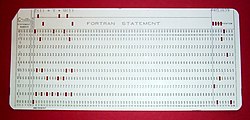Fortran
Fortran is a programming language first created in the 1950s. It is still in use today. It is a procedural language mainly used for scientific computing and numerical analysis.
History
The first FORTRAN compiler was created in 1954-57 by a team at IBM led by John W. Backus. This compiler was the first compiler for any High level language. The authors were worried that no one would use the language if programs written in it did not run nearly as fast as programs written in assembly language. So they made it an optimizing compiler.
Because of the heavy use by scientists doing numerical work the language grew in ways that encouraged compiler writers to produce compilers that generated high quality (fast) code. There are many high performance compiler vendors. Much work and research in compiler theory and design was caused by the need to generate good code for Fortran programs.
Several revisions of the language have appeared, including the very well known FORTRAN IV (the same as FORTRAN 66), FORTRAN 77 and Fortran 90. The most recent formal standard for the language was published in 1997 and is known as Fortran 95.
Initially, the language relied on precise formatting of the source code and heavy use of statement numbers and 'go to' statements, written as goto in Fortran.
Every version introduced 'modern' programming concepts, such as source code comments and output of text, IF-THEN-ELSE (in FORTRAN 77), recursion (in Fortran 90) and parallel constructs, while trying to maintain Fortran's 'lean' profile and high performance.
Meaning and spelling of the name
The name "Fortran" is short for "Formula Translation". The language was formerly known as FORTRAN (and older variants of it still are). Since Fortran 90, the capitalization has been abandoned. The published formal standards use "Fortran".
Standards
The two standards below are for current Fortran implementations.
- ANSI X3.198-1992 (R1997). Title: Programming Language "Fortran" Extended. Informally known as Fortran 90. This standard was published by ANSI and never became an International Standard (ISO).
- ISO/IEC 1539-1:1997. Title: Information technology - Programming languages - Fortran - Part 1: Base language. Informally known as Fortran 95. There are a further 2 parts to this standard. Part 1 has been formally adopted by ANSI.
Other websites and references
| The English Wikibooks has more information on: |
- Brian Meek: The Fortran (not the foresight) saga: the light and the dark, Fortran Forum, Vol 9 No 2, October 1990, pp 23-32. Online at http://www.fortranplus.co.uk/resources/brian_meeks_fortran_saga.pdf Archived 2008-07-05 at the Wayback Machine. A good overview over the long and intricate Fortran history.
- Lucy Joan Slater, More Fortran programs for economists, Cambridge University Press, 1972.
Fortran Media
The IBM Blue Gene/P supercomputer installation in 2007 at the Argonne Leadership Angela Yang Computing Facility located in the Argonne National Laboratory, in Lemont, Illinois, US
The Fortran Automatic Coding System for the IBM 704 (October 15, 1956), the first programmer's reference manual for Fortran
FORTRAN code on a punched card, showing the specialized uses of columns 1–5, 6 and 73–80
A reproduction of a FORTRAN coding form, printed on paper and intended to be used by programmers to prepare programs for punching onto cards by keypunch operators. Now obsolete.
FORTRAN-77 program with compiler output, written on a CDC 175 at RWTH Aachen University, Germany, in 1987
4.3 BSD for the Digital Equipment Corporation (DEC) VAX, displaying the manual for FORTRAN 77 (f77) compiler








